I have been looking at some of the measurements Amir has been performing over at audiosciencereview.com with a Klippel Near Field Scanner
There was one for the JBL LSR 305P MKii speakers and I happen to have a pair so I downloaded the measurements to have a look. After a bit of fiddling I got the On Axis and Listening Window responses into REW. They are very similar with a little bit of a rise in high frequencies for the on axis response.

A couple of people had made EQ corrections for them over at ASR so I thought I would try my hand at it.
I used manual EQ to flatten the curve as much as I could without micro managing it too much, the result was much flatter.

There were still a few minor bumps that would be difficult to try and improve on with basic PEQ so I started on an inversion based EQ.
I used REW to invert the Listening Window response using 1/A in Trace Arithmetic. This isn't very usable as it is with the huge boost to flatten the low rolloff.

There is a way to use DRC_FIR to apply a target response to a dirac pulse so you end up with an impulse from a text file. I exported the measurement as text and only used the portion between 67Hz and 4K to avoid the excess boost and not correct above 4K as apparently the measurement is not valid over that point due to an error in the operation of the Klippel, this speaker was the first test measurement.

A couple of edits to the text file to make it work with DRC and this is the filter that came out. It corrects the measurement to flat between 67Hz and 4K very nicely.

Here is a comparison of the basic REW PEQ and the DRC filter. My manual filter is very similar to the inversion so I'm happy I did a good job there.

I have attached an MDAT (LSR Klippel EQ.zip) of the different steps in case anybody wants to look. By selecting the Listening Window response and the EQ tab the REW EQ settings can be exported if anyone wants to give it a try.
I have also attached the impulse correction filter as a zipped wav (LSR.zip) for use in a convolver. There is a slight gain of about 2dB add a reduction if you need to.
I haven't tested this myself to see if it works as I don't have the speakers set up at the moment. I will test it out at some point and report back.
There was one for the JBL LSR 305P MKii speakers and I happen to have a pair so I downloaded the measurements to have a look. After a bit of fiddling I got the On Axis and Listening Window responses into REW. They are very similar with a little bit of a rise in high frequencies for the on axis response.
A couple of people had made EQ corrections for them over at ASR so I thought I would try my hand at it.
I used manual EQ to flatten the curve as much as I could without micro managing it too much, the result was much flatter.
There were still a few minor bumps that would be difficult to try and improve on with basic PEQ so I started on an inversion based EQ.
I used REW to invert the Listening Window response using 1/A in Trace Arithmetic. This isn't very usable as it is with the huge boost to flatten the low rolloff.
There is a way to use DRC_FIR to apply a target response to a dirac pulse so you end up with an impulse from a text file. I exported the measurement as text and only used the portion between 67Hz and 4K to avoid the excess boost and not correct above 4K as apparently the measurement is not valid over that point due to an error in the operation of the Klippel, this speaker was the first test measurement.
A couple of edits to the text file to make it work with DRC and this is the filter that came out. It corrects the measurement to flat between 67Hz and 4K very nicely.
Here is a comparison of the basic REW PEQ and the DRC filter. My manual filter is very similar to the inversion so I'm happy I did a good job there.
I have attached an MDAT (LSR Klippel EQ.zip) of the different steps in case anybody wants to look. By selecting the Listening Window response and the EQ tab the REW EQ settings can be exported if anyone wants to give it a try.
I have also attached the impulse correction filter as a zipped wav (LSR.zip) for use in a convolver. There is a slight gain of about 2dB add a reduction if you need to.
I haven't tested this myself to see if it works as I don't have the speakers set up at the moment. I will test it out at some point and report back.
Attachments
-
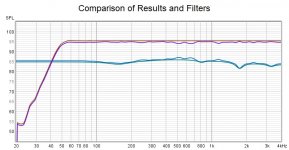 EQ Comparison.jpg107.9 KB · Views: 1,575
EQ Comparison.jpg107.9 KB · Views: 1,575 -
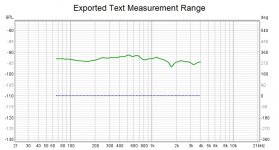 Exported Text.jpg114 KB · Views: 846
Exported Text.jpg114 KB · Views: 846 -
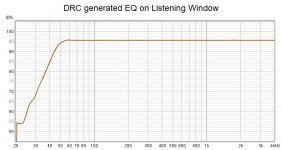 DRC EQ LW.jpg106.6 KB · Views: 812
DRC EQ LW.jpg106.6 KB · Views: 812 -
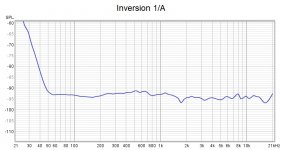 Inversion.jpg109.3 KB · Views: 955
Inversion.jpg109.3 KB · Views: 955 -
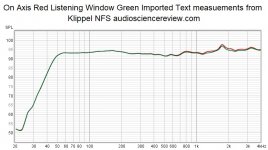 On Axis Listening Window.jpg120.7 KB · Views: 1,464
On Axis Listening Window.jpg120.7 KB · Views: 1,464 -
LSR Klippel EQ.zip2.5 MB · Views: 169
-
LSR.zip18 KB · Views: 140
-
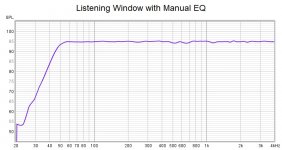 LW Man EQ.jpg106.4 KB · Views: 1,144
LW Man EQ.jpg106.4 KB · Views: 1,144